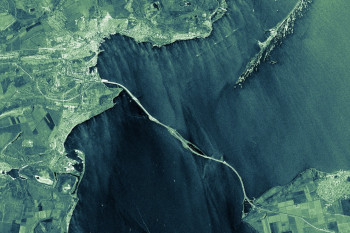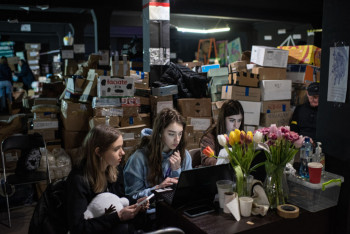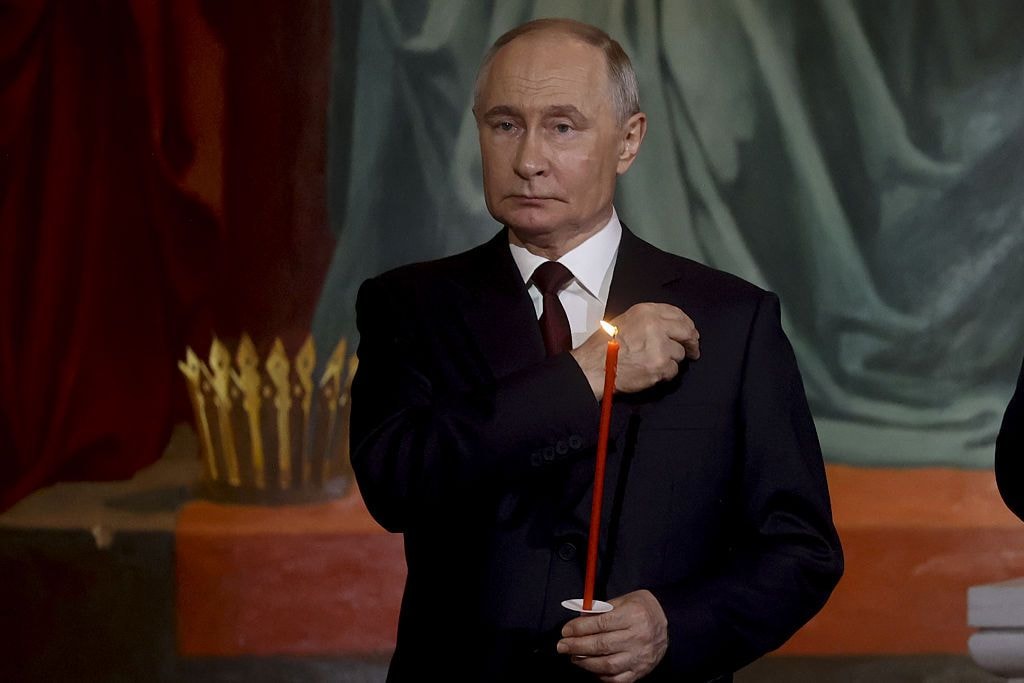How Elon Musk’s Starlink satellite internet keeps Ukraine online

Among the Ukrainian military, Elon Musk, the richest tech entrepreneur in the U.S., is often half-jokingly referred to as “Saint Elon.”
The reason is Starlink, Musk’s satellite communication system that keeps many Ukrainians, most importantly the military, online despite power outages and Russia’s attacks on the country's internet infrastructure.
Starlink allows access to the internet even during power outages or in the absence of other internet infrastructure. It is also more secure than other types of communication: Experts say that it’s nearly impossible for Russian troops to intercept.
It is also easy to use – it takes Ukrainian soldiers just up to 20 minutes to install a Starlink dish and connect to satellite internet, according to Eugene, a drone operator from Kharkiv. He declined to give his last name for security reasons.
"I use Starlink every day: to text my girlfriend, call my mom, and fly drones, of course," he told the Kyiv Independent.
Eugene’s military unit is based in a village with poor internet connection. The Starlink dish donated to the unit by local volunteers allows soldiers to use drones anywhere and quickly send data to a command center that analyzes the footage and plans strikes on the Russian military equipment.
Since the start of the full-scale invasion, Ukraine has received more than 20,000 Starlink terminals from foreign partners, volunteers, or directly from SpaceX, Musk’s spacecraft manufacturer that operates Starlink, according to Andriy Nabok, head of fixed internet development at the Ukrainian Ministry of Digital Transformation.
During the war, Ukrainians can use the terminals without paying a monthly subscription fee of $60, Nabok told the Kyiv Independent.
Portable white-and-gray Starlink satellite dishes can be mounted on the roof of the house, hidden in a shallow pit, or fastened to the hood of a car – anywhere with a clear view of the sky. When Ukrainian soldiers have to move positions, they carefully pack Starlink equipment and bring it to a new location, plugging the dish into a generator if the power goes out.
There are times when Musk's satellite internet is the only way for them to keep in touch with the outside world and tell loved ones that they are alive. Starlink enabled the Ukrainian troops trapped in the Azovstal steel plant in Mariupol to conduct live video interviews during the brutal two-month siege, calling the world to stop Russia’s terror.
The Ukrainian military relies on satellite internet to send encrypted messages to their commanders or connect drones that track and attack Russian forces.
Local internet providers, in turn, use Starlink to restore internet connectivity in heavily-shelled cities. In April, Starlink was used as a temporary solution to quickly restore the internet in the liberated areas of Kyiv Oblast, after Russian troops withdrew from it.
Ukrainian government officials praise the effectiveness of Musk’s internet and encourage foreign partners to donate more terminals to the country.
“I am really grateful for the support of Starlink,” President Volodymyr Zelensky said in an interview with Wired in June. “People who got out of the occupied cities, where there was no such assistance as Starlink, said that the Russians told them that Ukraine doesn’t exist anymore, and some people even began to believe it.”
Bringing Starlink to Ukraine
It took Ukraine one tweet to bring Starlink internet to the country.
It came from Ukraine’s Minister of Digital Transformation Mykhailo Fedorov just a few days into the full-scale invasion.
@elonmusk, while you try to colonize Mars — Russia try to occupy Ukraine! While your rockets successfully land from space — Russian rockets attack Ukrainian civil people! We ask you to provide Ukraine with Starlink stations and to address sane Russians to stand.
— Mykhailo Fedorov (@FedorovMykhailo) February 26, 2022
Fedorov started negotiations with SpaceX even before the invasion, but the red tape of bureacracy surrounding the country's telecom industry has delayed Starlink's launch.
Famous for his penchant for unconventional statements, Musk responded to the call swiftly and publicly.
“Starlink service is now active in Ukraine. More terminals en route,” he tweeted.
Musk’s response to Fedorov’s tweet was the green light for Starlink to provide satellite internet to Ukraine, SpaceX President Gwynne Shotwell said back in March.
For Musk, the launch of Starlink in Ukraine is not just a gesture of goodwill, but rather a PR move that shows other international partners the power of the technology. The U.S. Air Force, for instance, awarded Starlink a contract in early August for satellite internet in Europe and Africa after watching how it helped Ukraine stay online amid Russia's invasion.
In June, Starlink received a license from the Ukrainian government, allowing it to work officially and legally in Ukraine, according to Nabok. Before that, military and critical infrastructure sites were allowed to use it without a license. Now Starlink is available to regular customers.
Apart from Ukraine, Starlink’s fleet of over 2,000 low-earth orbit satellites provides internet access to 39 countries and aims for global coverage.
As of now, Ukraine has received 5,000 Starlink terminals from Poland, 5,000 from the American organization USAID, another 5,000 from EU countries, and the rest from SpaceX and private companies, Nabok told the Kyiv Independent.
At first, only those who needed reliable internet the most could get Starlink: the Ukrainian military, energy companies, hospitals, schools, media organizations, and IT firms. But now every Ukrainian can order Starlink equipment and connect to the satellite internet.
However, Ukrainians do not rush to jump on the bandwagon because Starlink is expensive. Ukraine has one of the cheapest internets in the world – about $7.40 for a monthly package (in the U.S. it costs $55, in Canada – $68, in the U.K. – $39).
Starlink‘s kit (a dish, a dish mount, and a Wi-Fi router base unit) costs almost $500 with a monthly service fee ranging from $60 to $100.
Starlink delivers equipment throughout Ukraine, except for the regions temporarily occupied by the Russians.
One of its main advantages is speed – up to 200 Mbps. The Ukrainian satellite internet provider Datagroup, Starlink’s main rival, offers satellite internet for $43 per month, but its speed is significantly lower – 20 Mbps.
Restoring internet infrastructure
Although the value of Starlink for ordinary users is questionable, for the army and critical infrastructure facilities – schools, banks, railways, hospitals – it is indispensable.
Ukrainian drone operators, for instance, equip their cars with Starlink dishes and electricity generators before going to the battlefield, according to Inna Shevchuk, director of Ukrainian drone unit Aerorozvidka.
At first, the military was afraid to use Starlink terminals because their signal could allegedly be detected by Russian electronic warfare systems, Shevchuk told The Kyiv Independent.
Musk also warned about the danger of using Starlink in a war zone and recommended turning on the terminal only when needed and keeping it far away from people.
Important warning: Starlink is the only non-Russian communications system still working in some parts of Ukraine, so probability of being targeted is high. Please use with caution.
— Elon Musk (@elonmusk) March 3, 2022
Like any software, Starlink is also vulnerable to cyberattacks. Musk said that Russia was “ramping up” its cyberattacks on his company, and SpaceX had to repeatedly rewrite its code to protect the network.
Despite these problems, Ukraine is not going to give up Starlink, as sometimes it is the only way to maintain communication with regions where the Russians have destroyed the internet infrastructure.

The operator of Ukrainian internet provider IMK restores internet connection in the city of Boryspil near Kyiv with the help of Starlink (Mykhailo Fedorov/Telegram).
The losses of the Ukrainian telecom market due to the war reached $2.6 billion in July. In order to return the internet to the liberated territories, Ukrainian mobile operators – Kyivstar, Vodafone, and Lifecell, combine their own equipment and Starlink’s tech.
They mount the Starlink receiver and its motorized base to their own mobile base station and attach a generator. Starlink is also used as a backup network, in case other networks are unavailable or destroyed.
The possibilities of Starlink will not be enough to cover all of Ukraine with high-speed internet, but the government is looking for ways to use it after the war.
“We recently tested how Starlink works in a car traveling at a speed of 130 km/h,” Nabok said.
This is the speed of modern Ukrainian Intercity trains operated by the state railway Ukrzaliznytsia. Currently, there is no internet on the trains, and travelers spend long rides relying on a very patchy mobile data connection. Starlink could finally change that.
“We were pleasantly surprised by the results of the test, so we are considering covering trains with high-speed internet, turning them into ‘offices on wheels’," Nabok told the Kyiv Independent.
____________________
Note from the author:
Hi, this is Daryna Antoniuk, I hope you enjoyed reading my story.
I cover tech for the Kyiv Independent during one of the most difficult times for my country. We need stories like these because the fight on the digital front is just as important as the fight on the ground. I really want to write again about investment in Ukraine’s hi-tech, cool startups and the booming Ukrainian IT market.
But first, Ukraine needs to win the war. Our part in it is keeping the world informed. Consider becoming a patron of the Kyiv Independent so you can read more stories about tech and business in the future.












